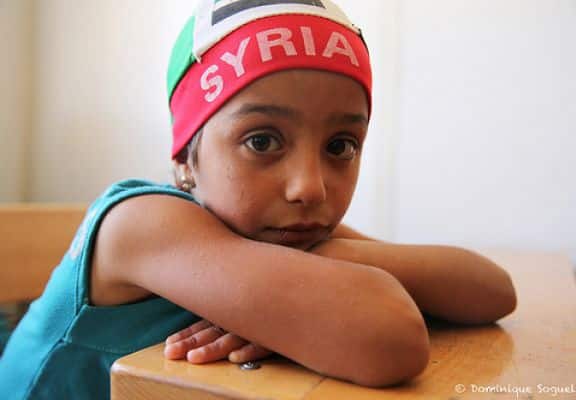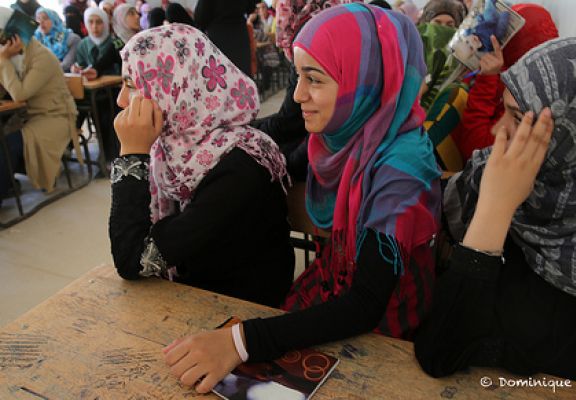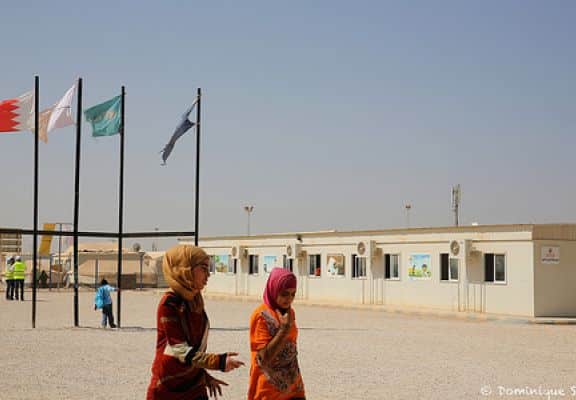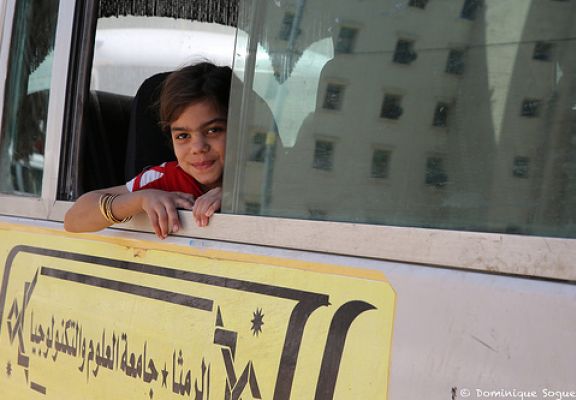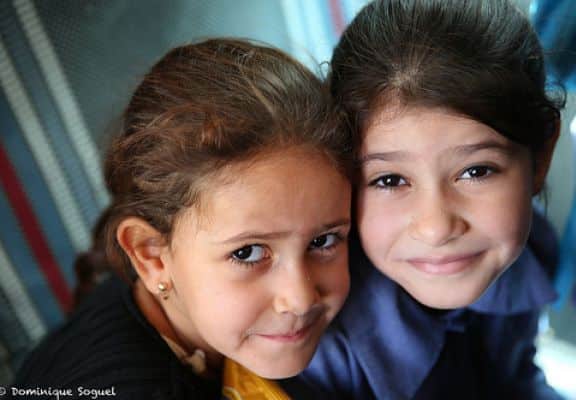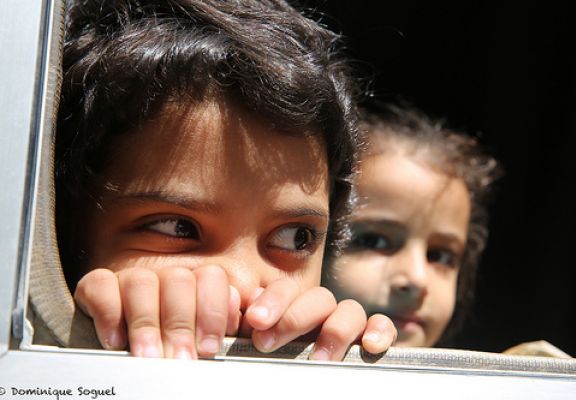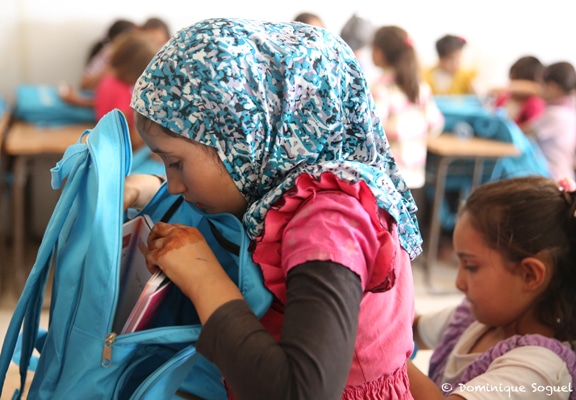

Credit: Dominique Soguel.
AMMAN/ZAATARI, Jordan (WOMENSENEWS)– Children across the region have been gradually returning to school throughout September after their summer breaks. But the vast majority of Syrian students, whether inside or outside the country, do not have that luxury.
Four Syrian refugee girls in that category can be found here in Salahiyet al-Abed, an area on the outskirts of Amman, playing in a shadeless street, chatting and singing songs in a breezy stairwell. They are among the three-quarters of the 150,000 Syrian school-aged children in Jordan who are unable to attend school.
Nuran, a 12-year-old from the cradle of the 2011 revolt against Syrian President Bashar al-Assad, from the Syrian town of Daraa, says she spends a large chunk of the day sitting inside with her mother and father because they couldn’t afford to send her to school.
She hopes to become a lawyer to “help release those who have been jailed unjustly.”
Her older sister, Gufran, wants to be a surgeon. Because of the conflict back home, which displaced their family several times within Syria before they traveled to Jordan, the two sisters have lost more than two years of education.
The last day that Nuran and Gufran attended school in 2011, in the outskirts of Damascus, an explosion blew out the windows of their classrooms, recalls their mother, Iman, who asked that her last name not be used to protect the family’s privacy.
“My girls stopped going to school after that,” she says. “They are dying to go back to school, but even if they want to go, I must be reassured of their safety. There is no bus here. It’s a back road and anybody could snatch them. How can we be sure of their safety?”
Two other sisters–Noor and Manar–from the neighborhood of Khalidiya in the city of Homs, tell Women’s eNews that if there were a bus, their parents would probably let them go.
“We miss school but not as much as Syria,” chimes 11-year-old Manar, who sports a bright blue hijab and a Hello Kitty T-shirt.
The four girls are friends and live in blocks of beige buildings in the outskirts of Amman along with dozens of Syrian families displaced by a conflict that has claimed more than 110,000 lives since its outbreak in March 2011, according to the Britain-based Syrian Observatory for Human Rights.
Makeshift Schools
In the basement of one of those buildings, two Syrian women Yusra and Arwa, who declined to give their last names due to security concerns for relatives back home, are doing what they can to keep their young charges focused on the alphabet. With only a few teaching props, such as crayons and markers, it’s no easy task. Like the children, the two women are refugees and are contending with trauma.
“The children are slowly overcoming it,” says Arwa, referring to trauma. “They are moving forward. In the beginning, if they heard an airplane they would all hide under the desks. In the beginning, I couldn’t stand in front of windows, because I still was scared of coming under sniper fire.”
The pair has no formal background in education and volunteered to run this makeshift kindergarten and primary school because half of the children in their immediate community — more than 60 families living in the two beige concrete buildings – are not registered in school.
“From about 100 kids, 50 are registered in school,” says Ibrahim Abu Omar, the manager of the complex funded by Kuwait and administered by an Amman-based Islamic charity. “We’ve created something that resembles a school to fill the gap.”
More than half a million Syrian refugees live in Jordan, concentrated in major cities such as Amman, Irbid and Mafraq.
One dimension of that crisis is the huge population of children going without school.
In Jordan, the numbers of unschooled children have surpassed 100,000 and UNICEF estimates that more than 3,000 schools in Syria have been damaged or destroyed since the start of the Syrian conflict and another 900 have been turned into shelters. Almost 2 million Syrian children have dropped out of school since last fall.
“For a country that was close to achieving universal primary education before the conflict started, the numbers are staggering,” said Maria Calivis, UNICEF‘s regional director for the Middle East and North Africa, in a press statement.
Three Obstacles
Poverty, lack of transportation and safety are the three major obstacles cited in recent interviews by parents who have moved to Jordan and wish to send their students back to school but can’t.
Boys often become breadwinners while girls are told to stay home for their safety or to help their mothers with child care.
“I want to register my kids in school but I don’t even have money to dress them,” sighs Noora Hussein, a refugee from Syria’s Idlib province. She lives in a Bedouin tent in the village of Zaatari with her six children and school is well beyond her means. She depends on her two eldest sons to eke a living selling vegetables and leans on her daughter to take care of the youngest siblings.
In the nearby Zaatari refugee camp, which is the largest Syrian refugee camp in Jordan and considered the second largest in the world, there are 30,000 school-age students and three schools that are only capable of enrolling a total of 15,000 students.
Of those registered in the camp, UNICEF says 53 percent are girls and 47 are boys.
To help keep children busy, UNICEF and other organizations have created child-friendly spaces in the Zataari refugee camp, where kids can play, socialize and get emotional support. About 2,800 children visit these 35 child-friendly spaces in the camp daily, according to UNICEF.
Some Turned Away
Outside the camp, the Jordanian Ministry of Education estimates that some 60,000 Syrian students are registered in public schools. This academic year, 40 public schools are accepting Syrian students, with a double-shift system introduced to cope with the load.
But many Syrian parents interviewed by Women’s eNews said they were turned away because schools are full, while others reported being too poor to take advantage of that offer or lacking the right papers to do so.
Two government schools a few miles away from the basement school run by the Islamic charity illustrate why.
Even though tuition is free, costs such as clothing, school supplies and transportation are too much, says Abu Faris, a native of the embattled Syrian town of Qussayr and the father of three children.
“The process of registration is easy but the majority of families can’t send their children to school because they don’t have the money to pay for notebooks. Aside from distance [to the schools], the main issue is cost.”
For girls, there’s also the problem of safety. To reach the nearest public schools, the refugee children living in Salahiyet al-Abed have to travel by foot up a winding rough road during the hottest hours of the day since the Syrian students’ shifts are in the afternoon.
“People are scared for the safety of their daughters, the hill is high and the road is rough,” says Arwa. “The lessons are scheduled when the sun strikes hardest. If adults struggle on that road, how are the little ones going to cope?”
Yusra says families are particularly protective of their little girls because they are “in a foreign country so they are extra cautious.”
Additional reporting for this article contributed by Juhie Bhatia in New York City.
Dominique Soguel, a journalist focused on the Middle East, is Women’s eNews’ Arabic site editor and head of a special Women’s eNews team reporting on female refugees in Jordan for the series Collateral Damage Syria: Women and Girls Fleeing Violence.
Would you like to Comment but not sure how? Visit our help page at https://womensenews.org/help-making-comments-womens-enews-stories.
Would you like to Send Along a Link of This Story? https://womensenews.org/story/war/130928/refugee-school-girls-in-jordan-sing-lyrics-loss
